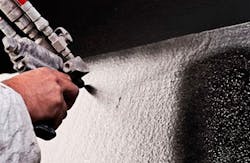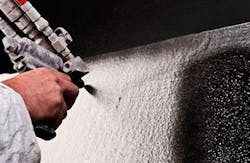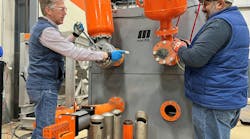It’s obvious that corrosion is a big problem in the process industries.
Corroded pipe repair or replacement costs industry more than $7 billion per year, the National Association of Corrosion Engineers estimates. This figure can double when lost revenue, productivity, and spill or leak cleanup costs are tallied.
"Corrosion is a major industry challenge — from external floating roof tanks, to tank interiors, to above- and below-grade piping systems — and particularly where pipes transition from above to below grade," says Scott Justice, tank division operations manager, Bolin Enterprises Inc. (BEI), a Casey, Ill.-based pipeline and tank maintenance contractor.
Traditional corrosion protection relies on short-lived, physically bonded coverings of substrate surfaces such as tapes and three-part coating systems (zinc, epoxy and urethane), as well as cathodic protection. These merely lengthen the time before a steel asset inevitably rusts.
In stark contrast, Justice turned to EonCoat, a Wilson, N.C.-based company that says it’s using a new category of tough, chemically bonded phosphate ceramics (CBPCs) to stop corrosion, extend equipment life and minimize cost and production downtime required to recoat, repair or replace corroded equipment. Its product is called, appropriately enough, "EonCoat."
An approach to corrosion protection
"What caught my eye about EonCoat was its unique adhesion and chemical properties," says Justice, who visited the company to view its corrosion testing lab, processes and procedures for the CBPC coating. "If its hard, outer shell is breached or knocked off, it still has corrosion protection where traditional coatings do not. Whether its coating is aged, beaten or banged around, it still protects the surface. If you remove the outer ceramic shell, the chemical bond with the substrate still stops corrosion at the surface."
In contrast to typical paint polymer coatings, which sit on top of the substrate, the anti-corrosion coating bonds, through a chemical reaction, with the substrate. Slight surface oxidation actually improves the reaction. This makes it impossible for corrosion promoters like oxygen and humidity to get behind the coating the way they can with ordinary paints. The corrosion barrier is covered by a true ceramic shell, which resists corrosion, fire, water, abrasion, chemicals and temperatures up to 1,000 F.
Traditional polymer coatings create a film structure that mechanically bonds to substrates that have been extensively prepared. If gouged, moisture and oxygen will migrate under the coating’s film from all sides of the gouge. Moisture and heat are then trapped by the film, creating a "greenhouse effect," promoting corrosion and blistering. By contrast, corrosion won’t spread based on the same damage to the ceramic-coated substrate because the steel is essentially alloyed. Its surface oxides are converted into an inert, electrochemically stable metal, incapable of supporting oxidation.
Ceramic coatings such as this consist of two non-hazardous ingredients that do not interact until applied by a plural-component spray gun like those commonly used to apply polyurethane foam or polyurea coatings. Since the components are not mixed and do not meet prior to application, the need for hazardous VOC-generating ingredients is eliminated, as are hazardous air pollutants and odor. This means that the work can get done in occupied areas.
"The results of the corrosion tank test were impressive," Justice says. Among the corrosion tests frequently run by the manufacturer of the CBPC product is one where the ceramic coating has gone more than 10,000 hours with no corrosion in a salt spray ASTM B117 test.
"If the coating works as well as we hope, it could help to stop or minimize corrosion and extend the longevity of a range of oil and gas assets," adds Justice.
Edge goes to the inorganic
Carbon polymer-based paints and coatings are by definition "organic" and can give corrosion a foothold, leading to microbe growth. Ceramic coatings are completely inorganic and are inhospitable to mold or bacteria.
"Since EonCoat is inorganic, it cannot sustain mold or bacteria growth," Justice says. "This could help to control corrosion issues related to mold growth on the external surfaces of water storage or elevated tanks, particularly when new oxygenated fuels are involved."
The protective ceramic coating can be applied on hot and cold surfaces from 40 F to 150 F in 0-95% humidity, excluding direct rain. While not widely considered, the Achilles heel of many traditional corrosion coatings may be in how exact the environmental conditions must be during their application to meet specifications. "A lot of coating products fail due to changes in temperature, humidity, dew point and other atmospheric factors during application," says Justice. "As conditions change seasonally throughout the year, it can be difficult to provide perfect coating conditions."
Since the ceramic coating takes temperature, humidity and dew point changes out of the equation during application, Justice says, "It can be reliably used in tough environmental conditions that might otherwise compromise the corrosion protection of typical coatings."
Shane Bartko, a director at TKO Specialty Surfaces, a Calgary, Alberta-based tank, pipeline, and structure maintenance contractor, has used the ceramic coating for corrosion control on a variety projects including storage and process tanks, refinery flare stack vessels, refinery sulfur plant roofing and a train-loading platform and towers.
Corrosion downtime slashed
"To keep a corrosive coating working well, you want one that will be resistant to high temperature, abrasion, chemicals, UV sunlight and other environmental factors," says Bartko. "EonCoat is strong in these areas. Just as important is how quickly it can get a facility up and running. As a comparison, in one example, what took us about four days with EonCoat, would have taken about 10 to 12 days with other coatings."
Time saved came both from simplified surface preparation and expedited curing time. "With a typical corrosion coating, you have to blast to white metal to prepare the surface," says Bartko. "But with the ceramic coating, you typically only have to do a NACE 3 commercial brush blast."
Bartko says that for coating projects using typical polymer paints such as polyurethanes or epoxies the cure time may be days or weeks. That’s how long it is before additional coatings can be applied. The cure time allows each coat to achieve its full properties, even though in a shorter period it may feel dry to the touch.
In contrast, a ceramic coating is applied only once, with almost no curing time necessary. Return to service can be achieved quickly. "With the ceramic coating for corrosion protection, we’re able to get facilities back up and running right away after spraying, sometimes in an hour," says Bartko. "Speed in getting a facility producing again can potentially save millions per day in reduced downtime. It makes sense to use the ceramic coating anywhere steel is used and may corrode, from pipelines and processing to storage."
Tony Collins is chief executive officer of EonCoat.
EonCoat industrial corrosion resistant coating represents 20 years of research at the U.S. Department of Energy Argonne National Laboratories. EonCoat ceramic barriers are now available for broad commercial and industrial application. For more info, email [email protected]; call 252-360-3110; visit www.eoncoat.com; or write to EonCoat, 4000 Airport Drive, Wilson, NC 27896.



